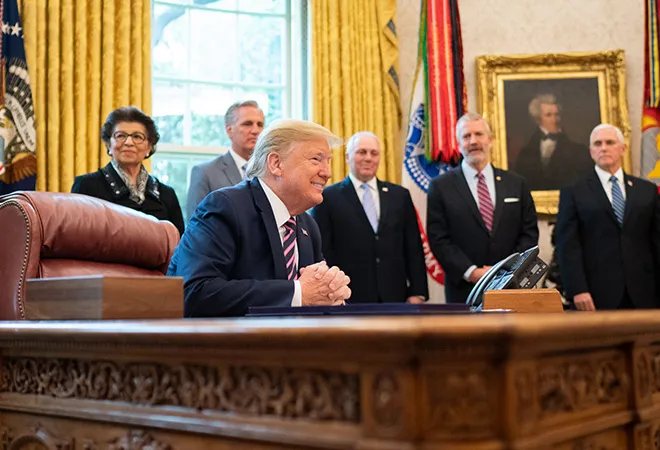It is now less than one year before the next United States (US) presidential election in 2020. Whether or not Donald Trump wins a second four-year term or loses to a Democratic challenger, a major question confronting the rest of the world — including India — is to what degree Trump’s foreign policies will outlive his presidency.
Assessing Trump’s foreign policy is inherently challenging. The high noise-to-signal ratio in his public pronouncements — whether in interviews, in rallies, or on Twitter — has a distortive effect. But so do personal grievances and intense political polarisation. Members of the US foreign policy firmament — those who traditionally interpreted the US for the rest of the world — are no longer impartial actors, and are often viscerally and emotionally opposed to Trump (Republicans sometimes more than Democrats). It is little surprise then that both US allies such as Germany, Canada, the United Kingdom, and South Korea and adversaries such as China have often fundamentally misread the current presidency.
But enough time has now elapsed to discern the broad contours of a Trump doctrine. It includes at least three key features. The first is a deep scepticism of multilateralism and a consequent emphasis on burden-sharing; the belief that other countries must do more to secure global public goods. Trump’s unilateralism is manifested in the US’ withdrawal from the Trans-Pacific Partnership, Paris Climate Agreement, and Iran nuclear deal. His strident calls for burden-sharing have jarred NATO allies, but have also extended to exhortations to India and others to do more to stabilise Afghanistan and secure the Persian Gulf.
A second key feature of Trump’s foreign policy has involved bringing adversarial relationships into sharper focus. The four key competitors regularly identified in US national security documents are China, Iran, Russia, and North Korea. While relations with the former two have become more hostile, Trump has made unsuccessful efforts to engage the latter two. An outreach to Moscow has been stymied by Russian political interference, domestic polarisation, and the orthodoxies of the US national security establishment.
Amid such heightened competition, Trump has adopted a somewhat paradoxical approach to the use of force. On the one hand, he is eager to bring an end to long-term US military obligations — so-called “endless wars” — in Syria and Afghanistan, although he has often been frustrated by his advisers. At the same time, Trump has been more willing to use force to achieve limited political objectives. This includes authorising the provision of lethal weaponry to Ukraine, more frequent freedom of navigation operations by the US Navy in the South China Sea, the use of the largest non-nuclear bomb in the US arsenal to strike Islamic State terrorists in Afghanistan, and the recent operation to kill Abu Bakr al-Baghdadi.
The third major pillar of the Trump doctrine involves resetting the terms of economic engagement with the rest of the world. The ongoing trade war with China may not yet have produced a deal with Beijing, but the new attitude to trade has resulted in an updated North American free trade agreement: the US-Mexico-Canada Agreement (USMCA). In the absence of immigration reform, the Trump administration has also implemented a hard (and often brutal) crackdown on illegal immigration and a more stringent enforcement of legal migration.
Some of these changes will be seen in hindsight as aberrations, but others will fundamentally alter US engagement with the world. No Democratic presidential candidate today can throw his or her full support behind free trade, open-ended military expeditions, or a disproportionately large role for the US in international security. In that sense, the unilateral moment in international politics may be well and truly over.
At the same time, a more competitive, and possibly adversarial, footing with China enjoys considerable bipartisan consensus, coloured by the Hong Kong protests, large-scale incarcerations in Xinjiang, and self-censorship on China by US companies (including the National Basketball Association). Antagonism towards Russia is also deeply entrenched in US politics, meaning that the strategic logic that once prompted the Nixon Administration to reach out to Beijing to cleave a wedge with Moscow will be difficult to replicate (although this time in reverse).
It is consequently hard to envision another Republican president in the near future promoting very different policies from Trump. The changes would be more to style than to substance. By contrast, progressive Democrats’ drive for a “Green New Deal”, their condemnation of Saudi Arabia for the war in Yemen, and sharpening identity politics suggest that a Democratic president would likely adopt very different approaches to climate change, Iran, and immigration.
Trump may, consequently, be seen in hindsight as having fundamentally altered US trade, security, and Asia policy, even if his imprint on immigration, climate change, and West Asia may prove more ephemeral. These dynamics will be important for the rest of the world — and not least observers in India — to appreciate. For New Delhi, any structural changes in US foreign policy will create certain long-term opportunities, including for military cooperation with the US. But they may also contribute to a vacuum that — at least in its broader neighbourhood — India will have little choice but to fill.
This commentary originally appeared in Hindustan Times.
The views expressed above belong to the author(s). ORF research and analyses now available on Telegram! Click here to access our curated content — blogs, longforms and interviews.




 PREV
PREV

